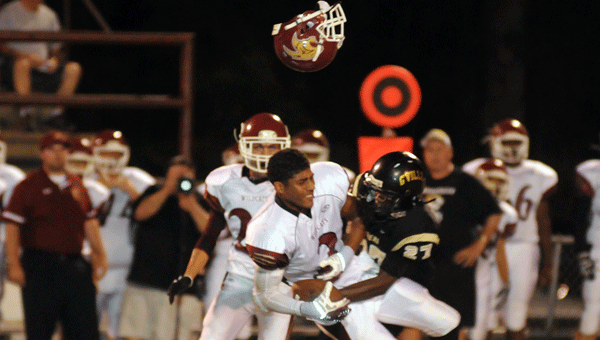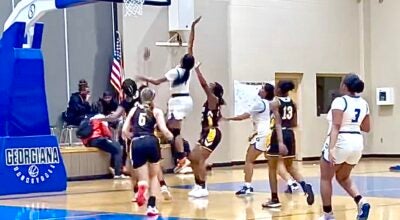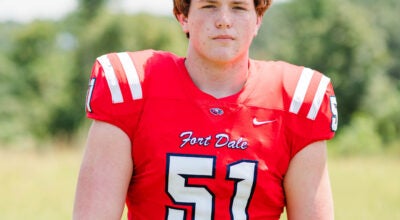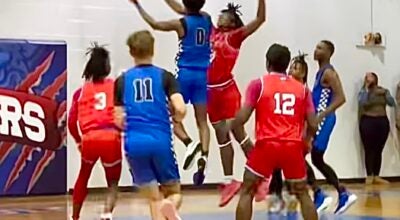Profesional weighs in on concussions’ impact on high school sports
Published 4:52 pm Tuesday, April 12, 2016

Former Greenville High School defensive back DeBryant Crenshaw separated a Citronelle High School wide receiver from his helmet during the Tigers’ 21-14 win over the Wildcats during a game in 2013.
With the NFL recently coming under fire for alleged attempts at hiding decades-old concussion cases, the concussion discussion has been reignited at all levels of play.
With more than three million cases each year in the US alone, concussions—which are defined as a blows to the head that can lead to temporary cognitive symptoms ranging from lack of coordination to memory loss— are one of the most prevalent injuries in sports. Dr. Prithviraj Chavan, orthopedic specialist at L.V. Stabler Memorial Hospital in Greenville, has seen his share on the Friday-night sidelines in Butler County.
According to Chavan, concussions suffered at the high school level are just as serious, if not more so, than those suffered at higher levels of play.
“It’s already been proven that there are higher incidents of concussions in high school athletes as compared to college athletes,” Chavan said. “It’s also been proven that it takes them longer to heal, and that has to do with the brain still not being mature. Those are known facts.”
Fortunately, the American Academy of Orthopedic Surgeons and numerous other medical societies have recommended new guidelines that prevent athletes suspected of or diagnosed with a concussion from returning to play on the day of injury.
With the sweeping guideline changes come new association rules governing practice for athletes.
Josh McLendon, head coach of the Greenville High School varsity football team, said that the new rules played a part in cutting down the number of serious injuries the Tigers sustained from previous years.
“The association has new rules, and they limit contact in practice during the fall,” McLendon said. “So you don’t have as much full contact in practice as you used to, which stems from the concussion issue.
“I think that helped, and I think teaching proper tackling techniques helps. Educating your players on concussion protocol and trying to make them aware of what the issues are can help. But it’s a fine line—it’s a contact sport, and it’s a sport that’s played very physically, so you’re going to have some injuries.”
Despite the changes, Chavan said that the rate of concussions at the high school level has increased, though he admitted that it could be contributed to the general improvement in diagnosing concussions.
According to Chavan, one in 20 high school football players will sustain a concussion in a given season.
Due to the fact that head and neck injuries account for 75 percent of the fatalities in high school football, conveying the importance of managing said injuries is of the utmost importance. As such, Chavan hosts seminars with area coaches prior to the start of the season to educate them on how to respond to worst-case scenarios.
McLendon said that the seminars are invaluable, but there are still improvements to be made in ensuring the safety of players, particularly on the practice field.
“We’re making sure that our coaches are qualified and certified in those areas so that they can assist players if there is some type of problem,” McLendon said. “We’re not fortunate enough to have a doctor or an athletic trainer at practice. An athletic trainer is something that we’re working on to have hopefully for the summer and fall, but that hasn’t come to pass yet.
“Jason Peavy does a really good job with our team, and he’s always available for us, but it’s tough. You have to be a coach, and you have to be an athletic trainer… you have to be a little bit of everything while you’re out there. Each coach is educated on what they can and can’t do, and we take all of those things very, very seriously.”
Though the conversation began with football, it’s hardly the only sport in which concussions can occur. Furthermore, Chavan said that there is a large misconception regarding the rates of concussions among male and female high school athletes.
“There was a study published by the National Athletic Trainers Association that found gender differences in the rate of concussions,” Chavan said.
“It said that in high school sports, female athletes are found to be at a higher risk of sustaining concussions than male athletes competing in the same sport. Soccer has 1.14 concussions per 100 players versus .92 for males. Even in basketball, it showed that females have a higher rate of concussions than males.”
But Chavan said that his biggest concern facing high school athletes, regardless of gender, was the danger of reentering play too soon after sustaining a concussion.
“Studies show that a lot of times high school kids will go back to playing sooner than they should, and that’s where the second challenging thing comes in, which is second-impact syndrome,” Chavan said.
“An athlete can sustain a head injury—most often a concussion—and will return to play while they’re still symptomatic and suffer a second injury, which can cause brain damage or can put them at a risk of death. We have to understand the importance of why they are out.”
Though there are inherent dangers in playing any contact sport, Chavan insists that there are plenty of precautions that can be taken at every level.
“It begins with the coaches, and helping them understand the symptoms of concussions,” Chavan said. “And educating the athletes on what the symptoms are, and not trying to demonstrate courage by playing through a concussion, which can cause a lifetime of symptoms.
“I cannot tell you how frustrating it is for me as a healthcare provider seeing them a week, or a few days later because they have been released by a licensed medical professional who probably does not have enough experience in concussions, and then the coaches send them back to me. I’m not trying to throw anyone under the bus, but we all need to feel accountable. We have to do a better job of educating ourselves, our teams, our coaches and our student athletes.”





